Voices of Indigenous Educators Series: “We’re all in this canoe together.” – Sui-Lan Hoʻokano
CompetencyWorks Blog
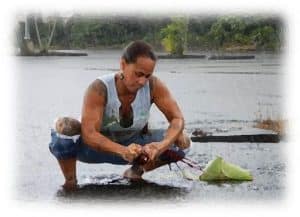 This post is based on an interview by the Aurora Institute (Laurie Gagnon) and the Liber Institute (Jonathan Santos Silva and Amanda Dahlin) on April 29, 2024 with Sui-Lan Hoʻokano, who is a Cultural Practitioner, Director of Winds & Waters LLC, and the Cultural Support Program Manager in Enumclaw School District.
This post is based on an interview by the Aurora Institute (Laurie Gagnon) and the Liber Institute (Jonathan Santos Silva and Amanda Dahlin) on April 29, 2024 with Sui-Lan Hoʻokano, who is a Cultural Practitioner, Director of Winds & Waters LLC, and the Cultural Support Program Manager in Enumclaw School District.
Aloha Sui-Lan Hoʻokano; No Hilo Hawaii au, kaikamahine a George Hoʻokano, Lucille Fernandez Fraticelli Hoʻokano. ʻO ka makuahine o ʻelima a me ke kūpuna wahine o ʻelima. I bring my Ohana (family) into this space with me and our ʻIke Kūpuna(knowledge of my ancestors). It’s important for me to introduce myself in one of my Native languages. It’s important for my genealogy, especially because our language was on the brink of extinction. I actually learned three of my languages later in life: Hawaiian, Spanish, and Chinese (Mandarin). This was part of my own restorative practice.
My dad’s Native Hawaiian and my mom’s Boricua; Taino Indian, Africana, Puerto Rican. She is seven generations from the islands of Hawaii, so she only knows Hawaii, and she knows some of her ancestral history, but not all, and we have to acknowledge that. I’m blessed with having an opportunity to learn some of my family’s histories. My name Sui-Lan is part of my Chinese ancestry as well, which is a very complex part of my history.
I have learned to bring 100% of everything that I am into space, and I think that’s important for us to unpack what this looks like for us as Native and Indigenous peoples. As I stated earlier there are some parts missing from our history that have purposefully been taken and erased – language, cultural traditions, history, stories. For me, acknowledging this keeps me aware of the work I still have to do with responsible humility.
It is also important for me to acknowledge the ancestral relationships that I have with this wahi pana (place with story) and places I visit. Maintaining relationships with the traditional stewards and lands of the Coast Salish Peoples, understanding my responsibility to the people and lands, is an important part of reciprocating my relationships in community and finding my purpose and place within.

What is the opportunity for learning that you are running towards? Why is this important in your community now?
I don’t know if I’m running towards something. I think I’ve always been paddling in it, and I’ll use my canoe metaphors because I’m from a canoe family and background. Historically and currently we have utilized our Wa’a (canoe) teachings to build community and maintain social, emotional, and physical wellbeing. As canoe people we traveled the vast oceans through the brilliance of our ancestors. We have connected with other Native and Indigenous people to collaborate and share our ways. We managed sophisticated land relations, food sovereignty, and shared in maintaining and managing the health and wellness of our communities and the Honua (earth).
While this is something that the educational world is looking towards to service the needs of historically underrepresented and marginalized students, communities, and families, know that this has existed since time immemorial: this is a way we transfer knowledge, and maintain connections. This is the way our ancestors taught us, and so it isn’t anything new to those of us who have maintained these practices. You can put all the acronyms you want – MBL (mastery-based learning), PBL (project-based learning), competency-based learning – what it really is, is Indigenous forms of transferring knowledge that have sustained us generationally. “We are still here. We still practice these teachings.”
Even though they tried to ban and remove these forms of knowledge and experiences from our communities, we held strong. One great example of our sharing of knowledge and collaboration with our Canoe communities locally and globally is the work being done in Washington State and Hawaii. We have been able to collaborate and build on educational pathways through these forms of knowledge – He Wa’a He Moku, He Moku He Wa’a, meaning “The canoe is an island, and the island is a canoe” – and Healing of the Canoe (HOC) curriculums. We teach math, science, history, arts, career and technical education, and language, but more important than that is how we should hold ourselves on land the way we would on the canoe: “Paddling as one and caring for our resources.”
As the world and education look to find solutions to the environmental, social, and economic issues we face today, it’s important to understand that these experiences were not just to pass knowledge; it was to perpetuate practices that serve future generations for our community’s well-being. I’m also going to highlight our environmental relationships, because we didn’t see the learning as separate from the responsibilities we had to maintain our connections to the Honua. It was through these learning experiences we maintained relationships, understanding responsible stewardship while learning, and therefore maintaining, deep connections.
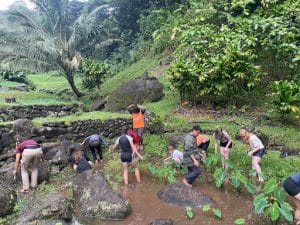
So, to answer this question, I think we’ve always been in the canoe, paddling in these directions to sustain cultural practices and wellbeing that will serve our community’s wellness for generations to come. We have always been in the Lo’i (a traditional Hawaiian taro patch), planting food to sustain generations and maintain our deep connections.
And to why it’s important for our community now, I will say it has never not been important to our communities. Now even more because, unfortunately, due to the impact of eurocentric and western education influences and social constructs, consumerism, and individualism, especially in the U.S., some of our own communities have been long removed and or lost connections to this way of learning and being. I think we really need to understand that it’s not just the systems and the oppressors that we need to work with – it’s within our communities as well, with people who have been removed and raised in a system that promotes individualistic thinking and consumerism.
We need to all understand what responsible education experiences look like for our future generations’ wellbeing.
For me, it’s important to understand who we are and what we’re here to do, even in the complexity of our own stories. We share our stories with our people, we share it with those who are not from our communities, because at one point in time, everybody was from an aboriginal community and responsible to that place, and we are all responsible to the Honua and humanity. When we share our experiences and stories with aloha, we bring heart and hope.
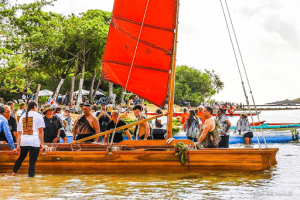
Who is helping you with your work? Who is paddling with you? Where are your ideas coming from?
That goes back to the ʻIke Kūpuna. Our elders taught us that learning wasn’t to learn something just to learn it, that you had Kuleana, which means I have a responsibility to those who’ve taught me how to hold myself in a community way, as a servant leader to this generation, to their generation, and then to the generations coming forward. So, the help comes from different parts of our history, our environment, our community, and our experiences, and I don’t exclude our non-human relations. A question I ask sometimes is how are we utilizing the environment as a co-teacher? Currently I am sharing with our Pacific and Coast Salish communities.
Our Kūpuna (elders) knew this, and so those who are paddling with me are the winds and waters of many sources. Those in our community that we get to share time with now, and those in the communities that have served. We really look at it generationally and in a holistic way.
My ideas are not my ideas, my words are not my words. I have experienced something in my lifetime that has gifted me knowledge and experiences, and with that comes a responsibility to continue sharing those stories. When we put it in those perspectives, we allow our youth to see that their learning is not just for them, we take it out of these individual contexts and we make it community-based. No matter what I’m studying, or what my career pathway will be, it is going to be for the benefit of all of us. In my language, this is the Kākou (collective) way of being and doing. We’re all in this together, for some of our relations it’s seven-generational thinking. This is another practice we share. What I do in this moment in time impacts future generations and what my ancestors did in their time impacted my generations; we are continuously in this reciprocal relationship.
I don’t own any of this; it is a transfer of knowledge from stories and experiences within the complex ecosystems that I have a Kuleana (responsibility) to.
In the full actualization of your dream, what does it look like and feel like? Where are you on the path? What are the steps you are taking?
I’m going to tell a story to describe that. I am in the Lo’i and I have been taught how to cultivate this food source that is going to feed our community and create a source of health and wellness and sustainability.
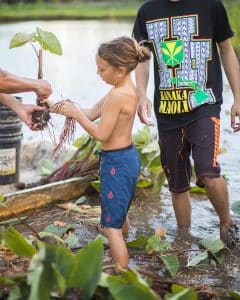
And in that space are my children, who are watching what I’ve been learning, what I’ve been taught by my own elders, and they’re practicing alongside me.
Then, I move forward a few years, and I’m sitting back watching my grandchildren now doing those same practices with my children. Then I go forward again, and those practices are being continued to serve our generational health, wellness, and community responsibilities.
I actually have pictures of four of my generations in the Lo’i.
We don’t have to, necessarily, step by step, tell them what to do. The experience is happening and through the experience of being with their family and their community and generational learning – that responsibility – is felt, not learned. There’s a difference when you experience something that sticks with you. That’s a part of sustaining your communities’ intellectual wellness, health and wellness, environmental wellness, and perpetuating cultural practices that serve the needs of the overall community. You just do it, you don’t have to be told, it’s just a natural part of what you are inherently contributing to.

So for me, if I envision this, I am able to see that transfer of knowledge through generations, through practices that were removed from our school systems but still maintained themselves in our community and in our lands and people. So how do we then create learning opportunities for our educational system, so that others can experience it in their education?
I don’t think there are words in our English language for ʻIke Kūpuna – this is a really beautiful way of just being in learning, being in community, holding your ancestral knowledge into a place where it’s received with love and responsibility. That’s Aloha, a way of being. It’s something that needs to be experienced in the environment, and in community. There are some things that we just can’t teach in a classroom and there are some things that don’t need to be in a classroom.
I think 50% of your curriculum walks in the door. The other 50% is outside, so how are we utilizing our environment to be that co-teacher with us, because we could learn so much from this collaboration.

How far or how close do you think we are to getting there?
In some spaces, we’ve been doing this work for a long time. We’re just not being recognized for that, such as when we talk about some of our beautiful immersion schools that are experiential learning spaces, founded in culture, and community-based.
When you do this in a Pono way – which means you do this in a way that is beneficial for all, with the right people, at the right time, for the right reasons – you begin to cultivate learners who have a community foundation. It’s not about the individual learner, what they’re learning, what their career is going to be. It’s about a community of learners that brings everyone along with them. Take away those individualistic mindsets and you now become community-based, and historically Indigenous communities based their decisions on what served the overall wellness of the community.
So what I’ll say is, when we have a few pockets of Indigenous educators and communities doing this work, who are transforming systems within the system, why are we still not valuing them and the work they are doing?
I do believe we are doing the work, and we are taking it out of the classroom. You need to get out of the brick-and-mortar and get outside and create these experiences for learning to stick. They call it experiential learning. I call it ʻIke Kūpuna. This is the transfer of knowledge that we’ve had since time immemorial.
When you partner and lift up the voices of our Indigenous communities and practitioners who have been doing this work but are not recognized as educators in this system, you begin to break down those walls that we’ve held power and control in. And by “we” I don’t mean me or us, I mean the system. We then allow learning to look like the community it’s supposed to be serving.
Knowing it’s messy and that you’re in a process, can you paint a picture of a moment when you felt it? A moment when you felt or you saw a glimpse of it and said, “This is what it will feel like every day.”
I got to Enumclaw in 2017, and I recognized that they weren’t valuing the rich and intellectual knowledge of our Native communities. I come from an immersion school background. In Hawaii they have been doing culturally based immersion schools and land-based traditional practices for some time.
So, I called the State out on some of their RCWs [Revised Code of Washington] and their WAC [Washington Administrative Code] rules. And I said, “Well, you say this, but you’re not really clear on how schools can do this.” I then wrote a policy for Enumclaw to incorporate these practices for education credits. But again in collaboration with those in the local area such as Willard Bill Jr., long-time educator and Muckleshoot Tribal member, who continues to be a partner in this work.
For me, as an educator and as a cultural practitioner, it’s important to showcase the value of diverse knowledge pathways and honor where that comes from. Now through mastery-based learning – which wasn’t there in 2017 and was not a clear pathway until 2020 – they utilized the work we have been doing as exemplary models. We are growing in this pathway.
So I think – not that I need the validation of state agencies or government agencies, because I don’t seek that either – that for those systems/agencies to begin to recognize that they could learn a lot from our communities when they do this work together [is a moment]. It’s not just to serve the betterment of our Native and Indigenous communities, but to also dismiss some of the power dynamics, stereotypes, and biases of systemic US education and what they’ve taught/not taught historically in schools. We can then collaborate together to create this wonderful experience for all students. I think this could be a moment, an opening for people wanting to do this work together.
Indigenous and Native people are not going to do this work all by ourselves, we will continue to do this with our communities. We also continue to look at how we can do this work together as a community with others who have the same goals.
And so some people got in the canoe and started to paddle with us. They’re clunky, they don’t know how to do their strokes, and they’re uncomfortable. But we’re showing them how to get their strokes aligned and paddle as one. They’re listening and we’re moving forward. We continue to teach each other so that we can all do what we’re supposed to do while we’re here.
I have five grandchildren. My oldest grandson just graduated from high school this year. I’ve got a two-month-old and an 18-year-old. I’ve got five children, and I am dependent on this world to create healthy opportunities for them to live and learn. That’s the goal.
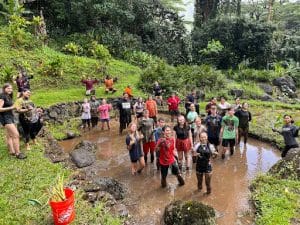
If you could wave a magic wand and change something, what would it be, and how would that change the trajectory of your work?
I don’t think I have an answer for that.
I think for me, there’s just not one answer for that, and I can’t wave that wand just once because I don’t have a pinpoint for it.

It’s like I don’t have a one-wand answer. There’s not one thing that I could change. It’s such a complex system and history that we live in. How could we wave a wand to change that complexity without maybe shifting the trajectory of something that was supposed to happen?
I appreciate you all for creating this opportunity in this space to talk story with me. Our agencies, and especially national and international platforms, can utilize their positionality to lift up the voices of our communities. We’re in the Lo’i we’re planting generationally, we’re busy planting and cultivating. So how are we bringing these complex stories into space so that others can feed from it?
I’ll leave you with one last canoe metaphor: we’re all in this canoe together. My papa taught us that you have to learn every seat in that canoe so that you know how to support your community and the various levels of responsibilities that come in those different seats. But you still have to paddle as one paddling community, or we won’t get anywhere. So I’m really grateful to share this canoe with you all today, as we all continue to paddle forward in this work.
This interview is part of a series exploring the intersection of Indigenous ways of learning and competency-based education (CBE). Through these conversations with Indigenous educators, the Aurora Institute and the Liber Institute aim to create a space for meaningful storytelling, celebrate resilience and innovation in Indigenous education, and inspire more inclusive, culturally responsive educational approaches.
Read more about Sui-Lan and the work in Enumclaw: Some WA schools opt for ‘show what you know’ system over letter grades (The Seattle Times).